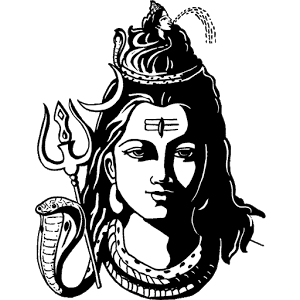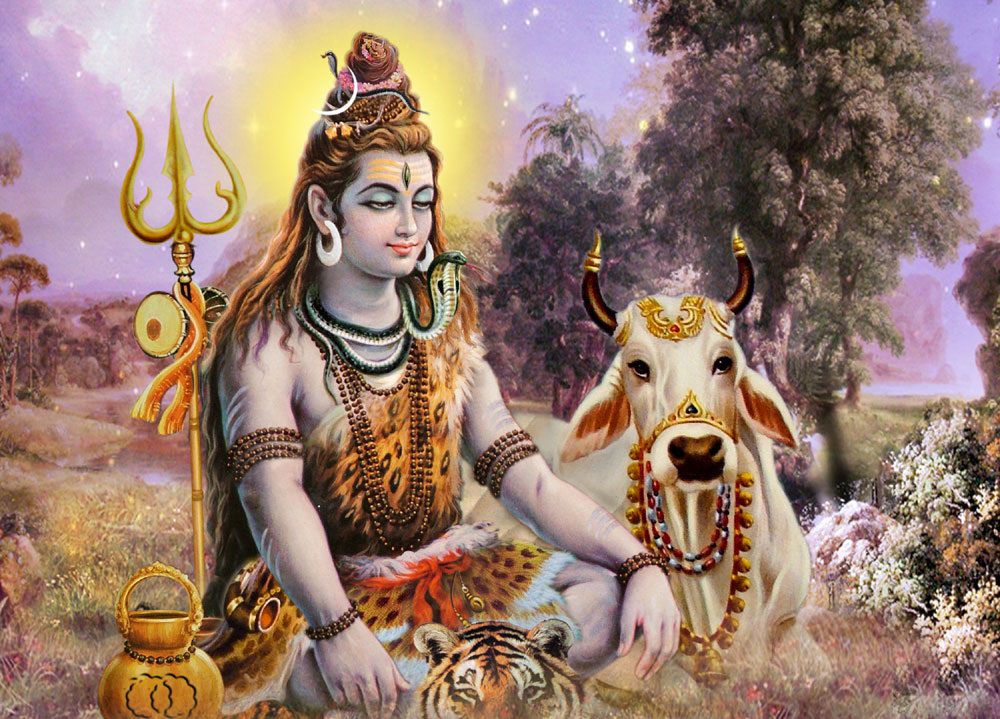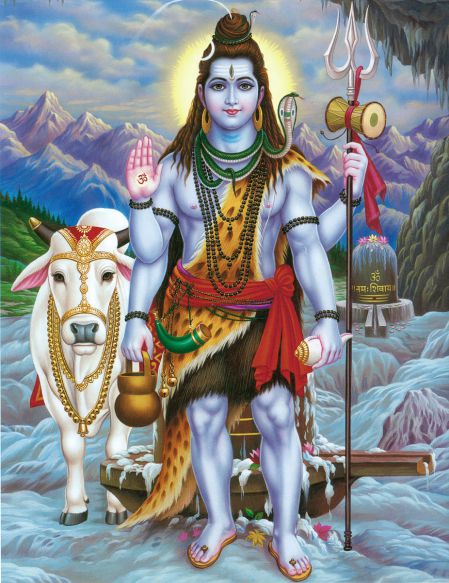No products in the cart.
At the highest level, Lord Shiva is regarded as formless, limitless, transcendent and unchanging. Shiva has many benevolent and fearsome depictions.
In benevolent aspects, he is depicted as an omniscient Yogi who lives an ascetic life on Mount Kailash, as well as a householder with wife Goddess Parvati and his two children, Ganesha and Kartikeya.
In his fierce aspects, he is often depicted slaying demons.
Shiva is also regarded as the patron God of yoga, meditation and arts.
The most important attributes of Shiva are :
- The trishul as his weapon.
- The damaru as his musical instrument.
- The adorning crescent moon and the holy river Ganga flowing from his matted hair.
- The snake Vasuki around his neck.
- An awaiting and patient Nandi.
- His tiger skin clad body.
- The third eye on his forehead.
The explanation of each is given below :
Symbols of Shiva
Trishul
Shiva’s trishul represents the three fundamental aspects of life. These are the three fundamental dimensions of life that are symbolized in many ways. They can also be called Ida, Pingala and Sushumna. These are the three basic nadis – the left, the right and the central – in the pranamaya kosha, or the energy body of the human system. Nadis are pathways or channels of prana in the system. There are 72,000 nadis that spring from the three fundamental ones.
The Pingala and Ida represent the basic duality in the existence. It is this duality which we traditionally personify as Shiva and Shakti. One can simply call it masculine and feminine and the certain qualities in each nature.
 Damru
Damru
Damru symbolizes the Universe which is always expanding and collapsing. From an expansion it collapses and then it re-expands. This is the very process of creation.
If one sees his heartbeat, it is not just one straight line but it is a rhythm that goes up and down. The whole world is nothing but rhythms; energy rising and collapsing to rise again. So the damru signifies that. The shape of the damru is like from expansion it collapses and again expands.
The damru is also a symbol of sound. Sound is rhythm and sound is energy. The whole universe is nothing but a wave function, it is nothing but rhythms and is just one wave (Adivata). So the damru signifies the non-dual nature of the universe.
Moon
There are many names for Shiva. One name that is very commonly used is Soma or Somasundara. Soma could literally mean the moon, but soma essentially means inebriation or intoxication. Shiva uses the moon as a decoration because he is a great yogi who is intoxicated all the time, but he sits in great alertness. To enjoy the intoxication, one must be alert. Even when one drinks, one tries to stay awake and enjoy the intoxication. And that is how yogis are – totally drunk, but fully alert.
Snake
A snake is also very sensitive to certain energies. Shiva has the snake around his throat. It is not just symbolic. There is a whole lot of science behind it. There are 114 chakras in the energy body. Out of these 114, people are usually talking about the 7 fundamental chakras in the system. Among these seven fundamental ones, the vishuddhi chakra is located in the pit of your throat. This particular chakra is very strongly associated with the snake. The vishuddhi is about stopping poison, and a snake carries poison. All these things are connected.
The word vishuddhi literally means “filter.” If your vishuddhi becomes powerful, you have the ability to filter everything that enters you. Shiva’s center is supposed to be vishuddhi, and he is also known as Vishakantha or Neelakanth because he filters all the poison. He doesn’t allow it to enter his system. Poisons are not necessarily that which one may consume through food. Poisons can enter one in so many ways : a wrong thought, a wrong emotion, a wrong idea, a wrong energy or a wrong impulse can poison his life. If his vishuddhi is active, it filters everything. It saves him from all these influences. In other words, once vishuddhi is very active, that person is so powerful within himself that whatever is around him does not influence him anymore. He is established within himself. He tends to become a very powerful being.
Nandi
Nandi, the vehicle of Shiva, is a symbolism of eternal waiting, because waiting is considered to be the greatest virtue in Indian culture. One who knows how to simply sit and wait is naturally meditative. Nandi is not expecting Shiva to come out tomorrow. He is not anticipating or expecting anything. He is just waiting. He will wait forever. That quality is the essence of receptivity. Before one goes into a temple, one must have the quality of Nandi – to simply sit. He is not trying to go to heaven, he is not trying to get this or that – one just simply sits.
That is the quality of Nandi – he just sits, alert. This is very important – he is alert, not sleepy. He is not sitting in a passive way. He is sitting, very active, full of alertness, full of life, but just sitting – that is meditation.
 Tiger Skin
Tiger Skin
Lord Shiva is often seen wearing tiger skin, or walking with the skin wrapped around him. According to folklore, the tiger skin signifies Shiva as the controller of all the powers in the world.
Lord Shiva sitting on a slain tiger skin symbolises the victory of the divine force over animal instincts.
A tiger skin symbolizes potential energy. Lord Shiva, sitting on or wearing a tiger skin, illustrates the idea that He is the source of the creative energy that remains in potential form during the dissolution state of the universe. Of His own Divine Will, the Lord activates the potential form of the creative energy to project the universe in endless cycles.
The tiger is the vehicle of Shakti, the Goddess of power and force. Shiva is beyond and above any kind of force. He is the master of Shakti. The tiger skin that he wears symbolises victory over every force. Tigers also represent lust. Thus by sitting on Tiger skin or by wearing one, Shiva indicates that he has conquered lust.
Third Eye
Shiva has always been referred to as Triambaka because he has a third eye. The third eye means another dimension of perception has opened up.
The third eye of Shiva is the eye of vision. The two physical eyes are just sensory organs. They feed the mind with all kinds of nonsense, because what one sees is not the truth. One sees this person or that person and he thinks something about him, but he is not able to see the Shiva in him. He sees things the way it is necessary for his survival. Another creature sees it another way, as is necessary for its survival. This is why we say this world is maya. Maya in Hinduism means the world is illusory. We are not saying that existence is illusory. We are only saying the way one is perceiving is illusory. So another eye, an eye of deeper penetration, has to be opened up. The third eye means one’s perception has gone beyond the dualities of life. He is able to see life just the way it is, not just the way that is necessary for his survival.

Other Lord Shiva Articles You May Like








